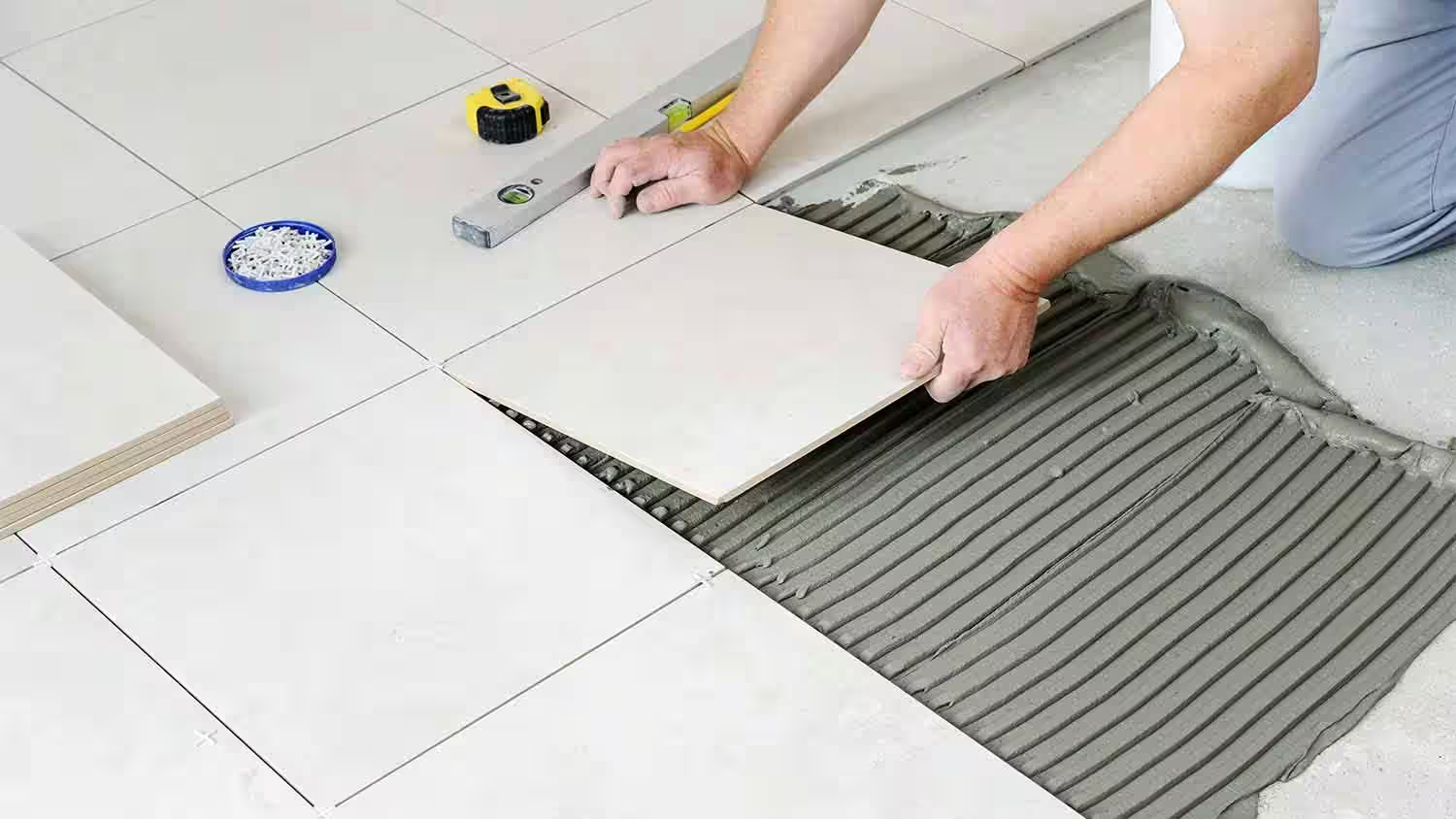
Everything You’ll Need
| Tool / Material | Ceramic Tile | Porcelain Tile | Purpose | |||||||||||||||||||||||
|---|---|---|---|---|---|---|---|---|---|---|---|---|---|---|---|---|---|---|---|---|---|---|---|---|---|---|
| Tape Measure | ✔ | ✔ | Measure room size and tile spaces | |||||||||||||||||||||||
| Chalk Line | ✔ | ✔ | Mark center lines and guides | |||||||||||||||||||||||
| Straight Edge | ✔ | ✔ | Guide straight cuts and lines | |||||||||||||||||||||||
| Pry Bar | ✔ | ✔ | Remove baseboards or old flooring | |||||||||||||||||||||||
| Spacers | ✔ | ✔ | Keep grout spacing even | |||||||||||||||||||||||
| Notched Trowel | ✔ | ✔ | Spread mortar on the floor | |||||||||||||||||||||||
| Mixing Paddle & Drill | ✔ | ✔ | Mix mortar and grout well | |||||||||||||||||||||||
| Wet Saw or Tile Cutter | ✔ | ✔ | Cut tiles for edges and corners | |||||||||||||||||||||||
| Utility Knife | ✔ | ✔ | Trim underlayment or score board | |||||||||||||||||||||||
| Level | ✔ | ✔ | Check tiles are even | |||||||||||||||||||||||
| Grout Float | ✔ | ✔ | Push grout into joints | |||||||||||||||||||||||
| Bucket & Sponge | ✔ | ✔ | Clean tiles and remove grout haze | |||||||||||||||||||||||
| Knee Pads | ✔ | ✔ | Protect knees on the floor | |||||||||||||||||||||||
| Safety Glasses | ✔ | ✔ | Eye protection when cutting | |||||||||||||||||||||||
| Gloves | ✔ | ✔ | <td
| Installation Method | Best For | Strength & Durability | DIY Friendliness | Notes |
|---|---|---|---|---|
| Thinset Mortar | Floor tiles, wet areas, large spaces | ⭐⭐⭐⭐⭐ (Excellent) | Moderate | Standard for tile flooring. Handles moisture, weight, and movement well. |
| Tile Adhesive (Mastic) | Small dry spots, wall tiles | ⭐⭐ (Limited) | Easy | Not for floor tiles or wet areas. Quick to apply but less durable. |
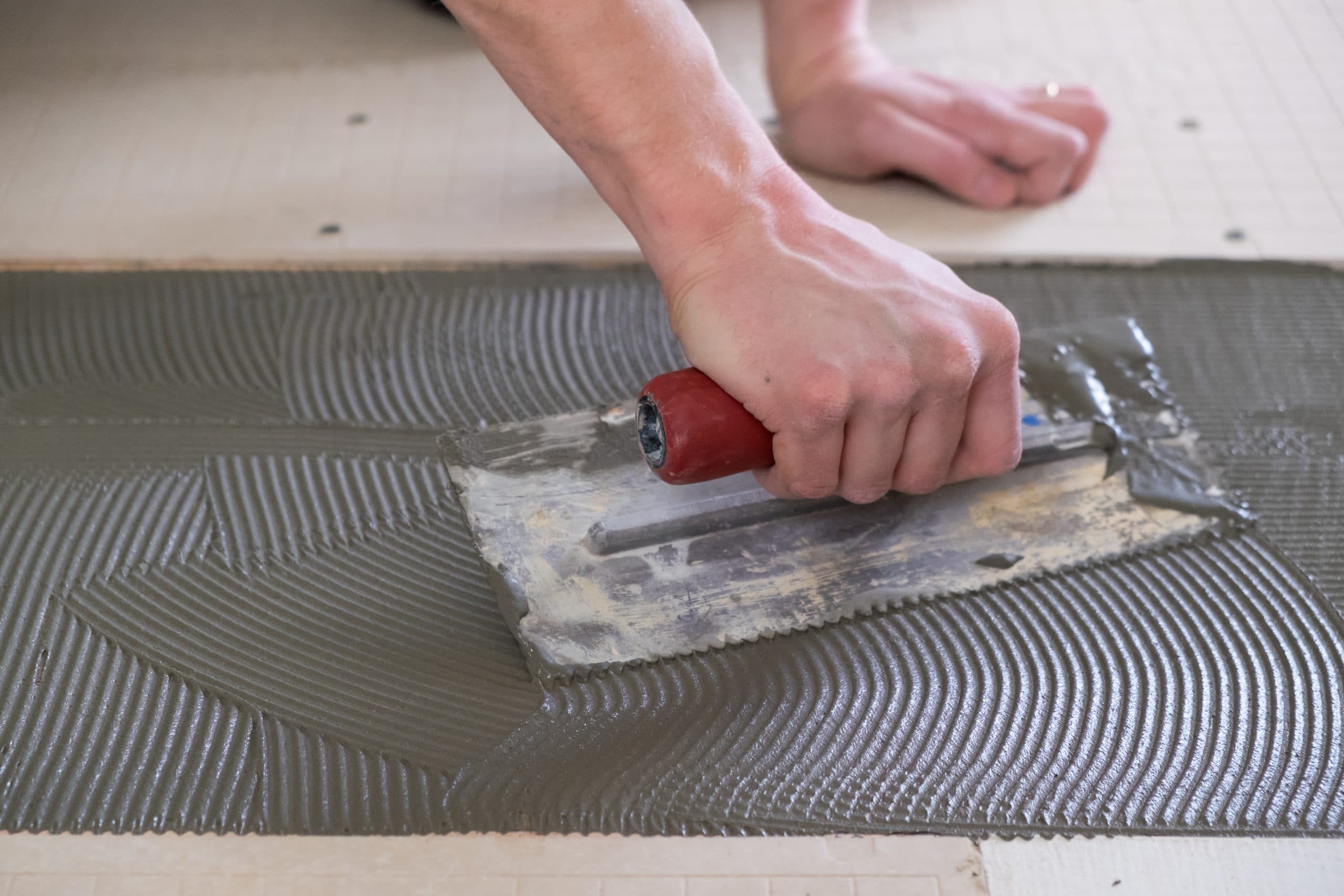
Step 4: Mix Mortar and Apply to Subfloor
Mix the Mortar
First, mix the thinset mortar as the maker says. Use a clean bucket and a drill with a mixing paddle to make it smooth and without lumps. Let it sit for a few minutes, then mix again before you use it.
Spread the Mortar
With a notched trowel, spread the mortar evenly over a small part of the floor. Hold the trowel at a 45-degree angle to make even ridges. These ridges help the tile stick well and ensure the right depth for a level install.
Work in Small Sections
Cover only as much area as you can tile in 10–15 minutes. This stops the mortar from drying before the tiles are placed.
Pro Tip:
Put a thin layer of mortar on the back of large tiles (back-butter) for better sticking, especially for tiles over 12 inches.
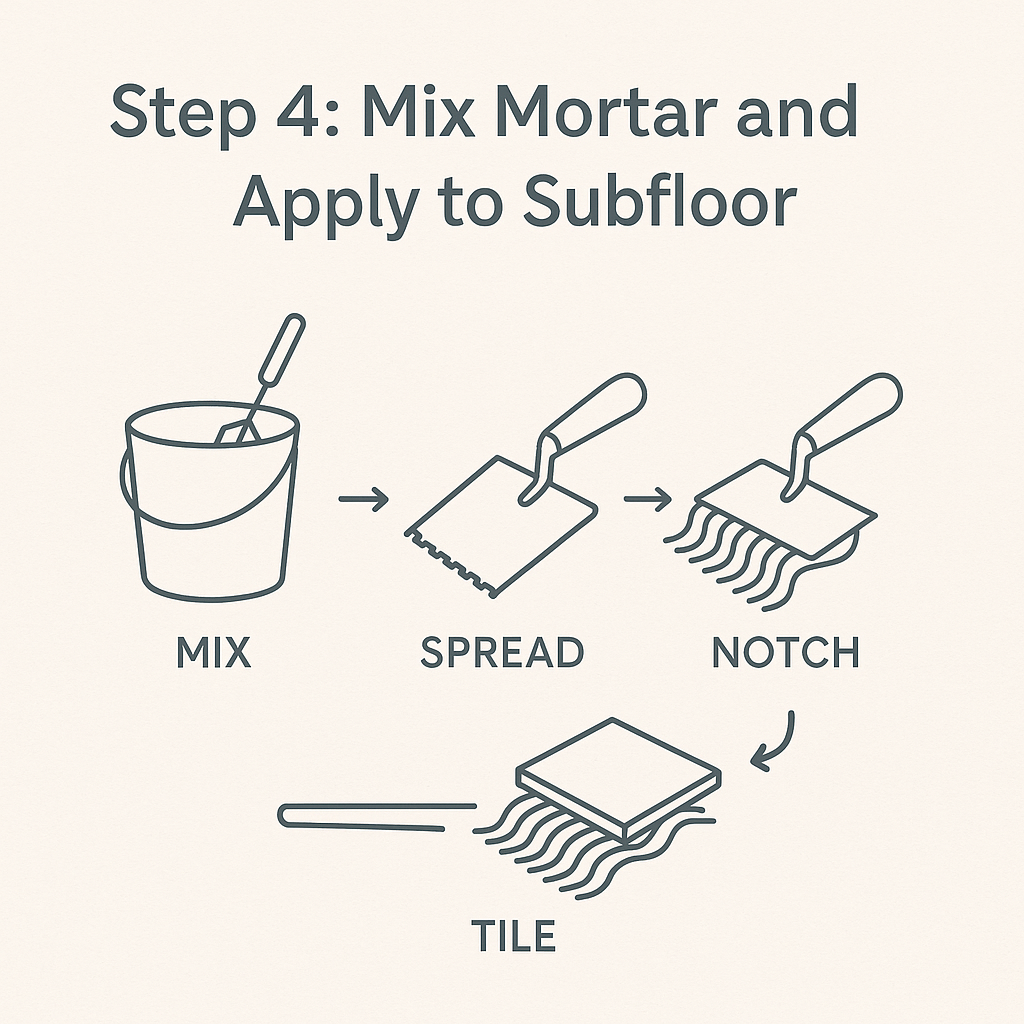
Step 5: Lay the First Tiles
Starting right will make the whole project better.
Start at Center Point
Use chalk lines from your plan. Begin at the room’s center or main spot. This makes tiles spread out evenly.
Place First Tile
Put the first tile on the mortar. Press hard and twist a bit to make it stick.
Use Tile Spacers
Put spacers between tiles to keep gaps even for grout. This makes a neat finish.
Check Level
After some tiles, use a level to make sure it’s even. Fix it before mortar dries.
Pro Tip:
Work in small parts so mortar stays wet until tiles are set!
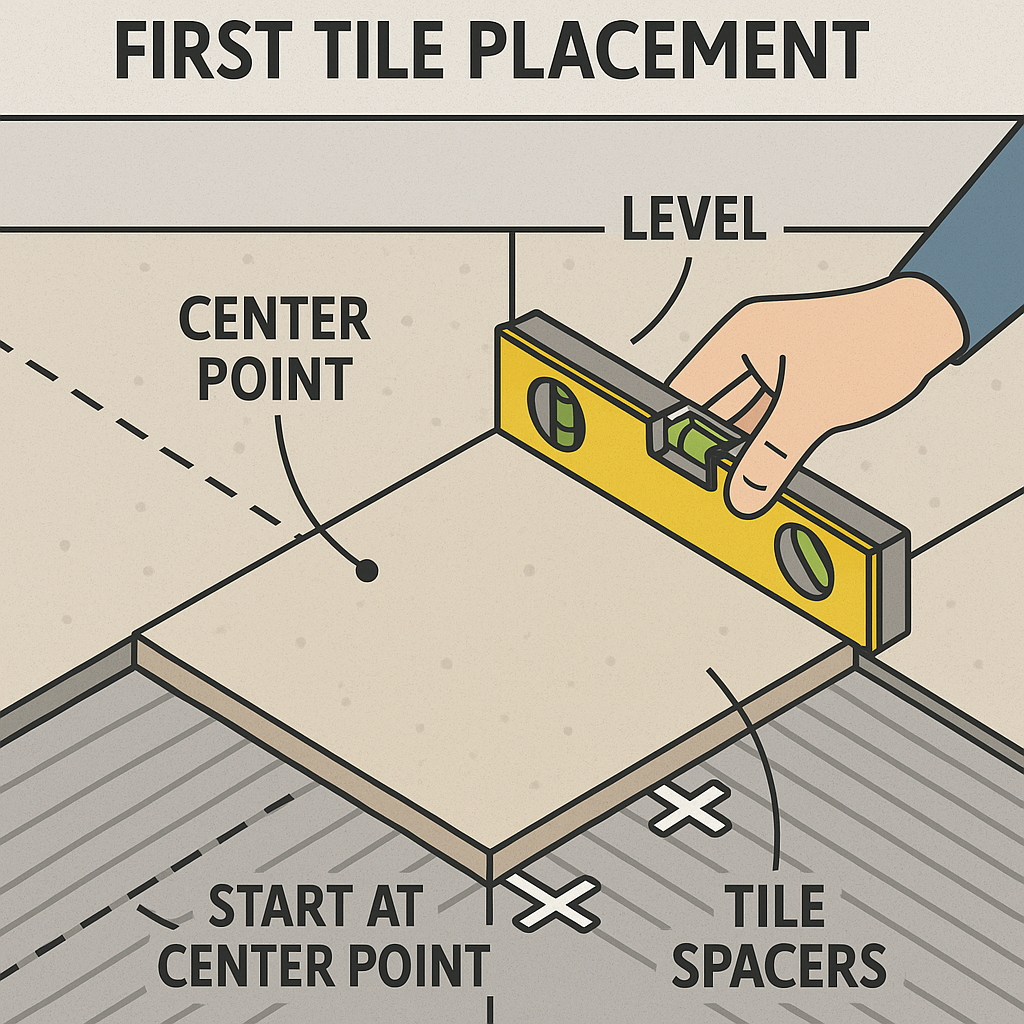
Step 6: Cutting Tiles to Fit
Cutting correctly is important for a nice finish.
Measure and Mark
Use a tape measure to find the tile size you need. Clearly mark the line with a pencil.
Choose the Right Tool
For straight cuts, a manual tile cutter is good.
For curved or intricate cuts, use a wet saw or an angle grinder with a diamond blade.
Cut in a Safe Area
Make cuts outside or in a space with good airflow to avoid dust. Wear safety glasses and gloves for safety.
Pro Tip:
Measure twice before cutting to save material and make sure it fits!
Step 7: Install Remaining Tiles and Let Mortar Cure
After setting the first tiles, keep placing the rest in rows. Start from your first spot, placing each tile with spacers to keep grout lines even. Check often to ensure tiles are level and adjust if needed to avoid bumps.
As you lay tiles, don’t step on the new ones to avoid moving them. Work in small areas so the mortar doesn’t dry before the tiles are set.
Once all tiles are in place, let the mortar cure for at least 24 hours (or follow the maker’s advice) before grouting. Proper curing is key for a strong, lasting tile floor.
Step 8: Apply Grout
After the mortar is dry, grout the spaces between the tiles:
Mix the Grout
Mix the grout as per the instructions until it is smooth like peanut butter.Spread Grout Using a Float
Hold a rubber grout float at a 45° angle and spread the grout over the tiles. Press firmly to fill all joints.Remove Excess Grout
After filling, use the float at a steep angle to scrape off extra grout from the tiles.Clean the Tiles with a Damp Sponge
Wait 10-15 minutes, then gently clean the tile with a damp sponge. Rinse often and avoid taking grout from the joints.Final Buffing
When the grout hazes the tile (after 30–60 minutes), use a dry microfiber cloth to buff the surface and clear the haze.
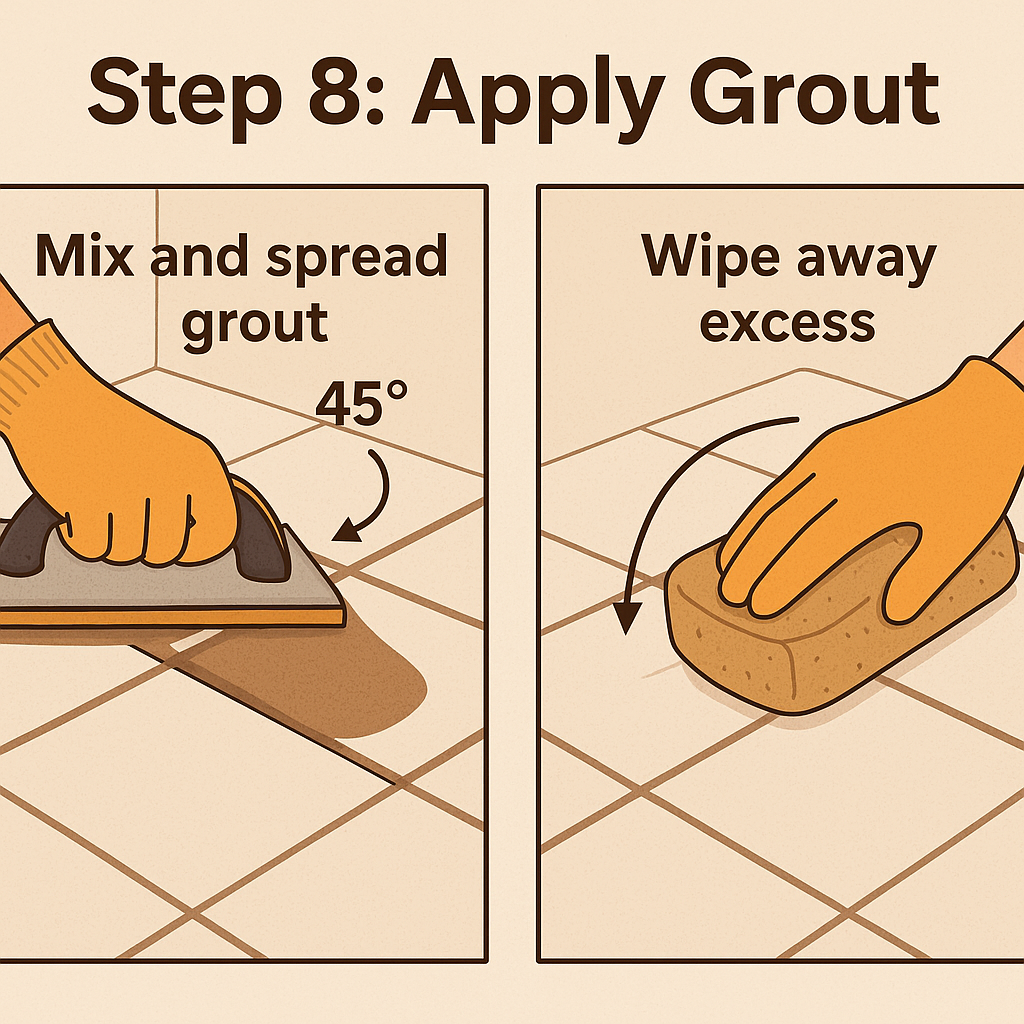
Step 9: Clean and Seal the Floor
Clean Grout Haze
After grout dries (usually in 24 to 48 hours), you might see a haze on the tiles. Use a damp sponge or a special cleaner to gently wipe the tiles. Be careful with the grout lines.
Seal Grout
If suggested by the grout maker, apply a sealer to keep grout safe from moisture, stains, and mold. Use a small brush or a bottle with a roller for accuracy. Let the sealer dry fully as per the instructions.
Put Back Baseboards and Strips
After cleaning and drying, put back your baseboards and add any needed strips between different floors or rooms. This makes your tile floor look neat and finished.
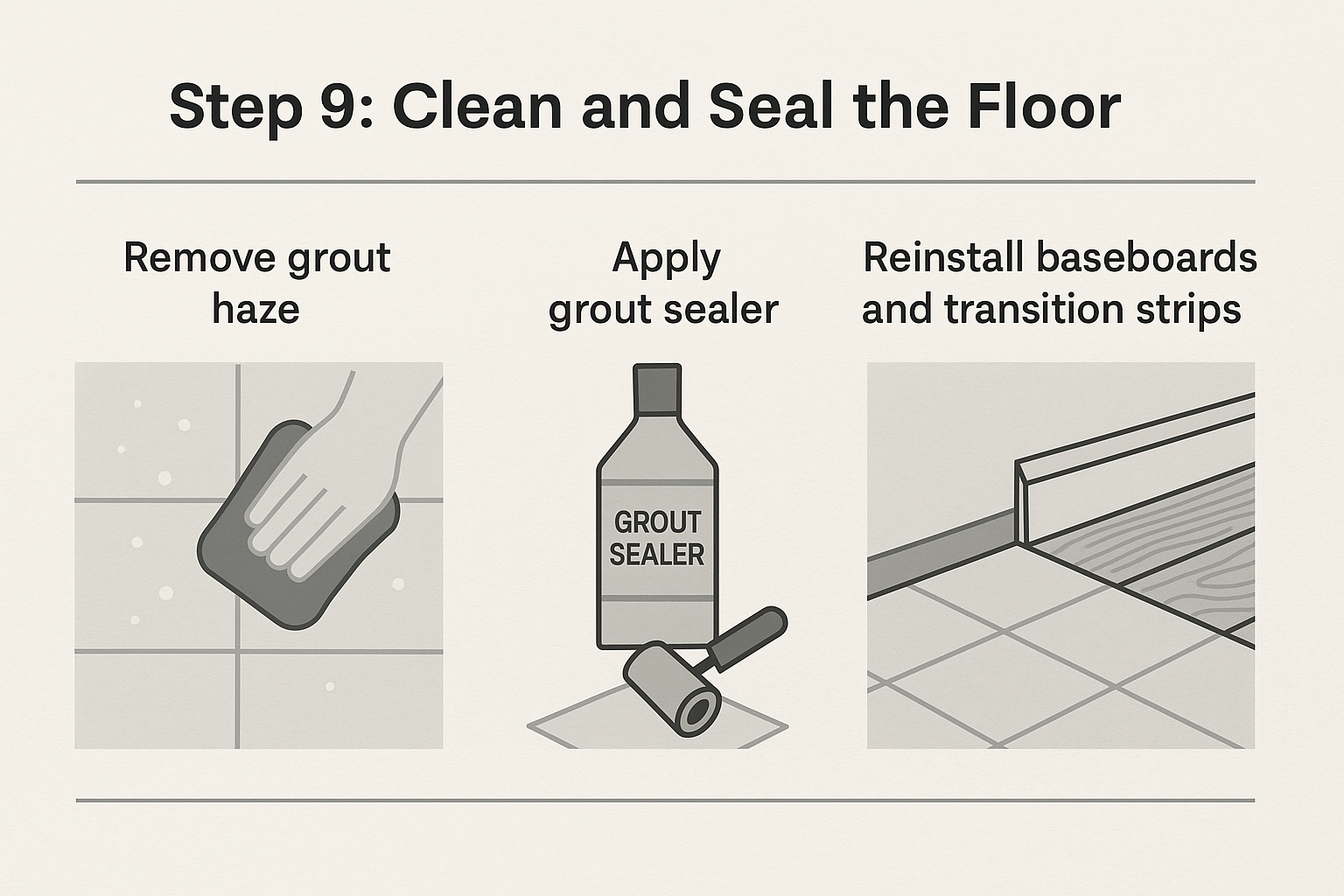
DIY vs. Professional Tile Installation
Doing tile flooring yourself can save money, but it might not be the best for every job. Decide if DIY or a professional is better for you.
DIY Pros
Lower upfront cost
Work at your own speed
Works well for small, easy rooms (bathrooms, laundry rooms)
DIY Cons
Needs time, precision, and special tools
Mistakes can be costly
Hard for complex layouts or big spaces
Professional Installation Pros
Expert accuracy and durable results
Faster work, great for big areas
Includes prep, cutting, and cleaning
Warranties often included
Professional Installation Cons
Higher initial cost
Less control over timing
Cost Comparison
Here’s what you might pay:
| Installation Type | Average Cost per Sq Ft | Typical Total for 250 Sq Ft |
|---|---|---|
| DIY Installation | $2 – $8 (materials + rental tools) | $500 – $2,000 |
| Professional Installation | $8 – $25 | $2,000 – $6,250 |
👉 For a full breakdown, check out our Tile Flooring Cost Guide.
Pro Tips for a Successful Tile Flooring Installation
Want pro results for your DIY tile work? Remember these tips:
Save time by setting up tools and tiles first. Put tiles and tools close by.
Use a good wet saw for clean cuts, especially on porcelain tiles.
Mix small amounts of mortar and grout. This stops them from drying too soon.
Check level often with a spirit level while placing tiles.
Work in small areas. This keeps mortar from drying before tiles are set.
Reduce breakage. Cut tiles slowly and always wear safety glasses.
Common Mistakes to Avoid When Installing Tile Flooring
Even skilled DIYers can make these mistakes:
Not leveling the subfloor. Uneven subfloors cause cracked tiles and crooked lines.
Not using spacers. Uneven grout lines look unprofessional.
Walking on tiles before mortar sets. This shifts tiles and messes up alignment.
Using too much or too little mortar. It causes poor adhesion or uneven tiles.
Not cleaning grout haze soon. Leaving it too long makes it tough to remove.
Do You Need Professional Help With Your Tile Flooring Installation Project?
Now that you’ve learned how to install tile flooring step-by-step, you’re ready to make a strong and beautiful surface that lasts a long time. If you prefer, our experts can handle tasks like leveling, cutting, and grouting for you.
Our skilled flooring installation team takes care of everything, from getting the subfloor ready to placing and sealing each tile perfectly. We help you choose the best tile style and materials for your needs and budget.
Contact us today to schedule your free in-home consultation and check if we serve your area!
Request a consultation
Meet with one of our skilled project specialists to get started
5920 Snow Creek Dr, The Colony, TX 75056 | (469) 756-0242
Company
Products
Get In Touch
North Dallas Flooring
5920 Snow Creek Dr, The Colony, TX 75056
(469) 756-0242





